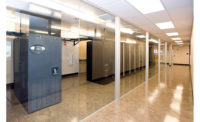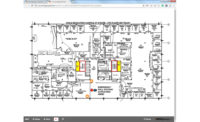The pandemic has brought changes for wholesale central stations. UL has temporarily allowed central station operators to work from home, provided certain requirements were met; and multiple wholesale central stations chose that option — others went a different route.
The pandemic didn’t stop central stations from moving ahead with a range of technology upgrades, though. Several central stations told us about new text-based alternatives to traditional phone contact lists, and at least two are offering hosted central station services to other central stations.
Integrating central station software with the software that supports end users’ ability to interact with their security systems via smartphone is another hot development area. And some central stations have developed their own unique technology and business initiatives that may not qualify as trends today but could tomorrow.
Acadian Monitoring Services
Lafayette, La.-based Acadian Monitoring Services has had great success with a smartphone app designed to enable anyone who is on the go to alert the central station to summon help when they feel threatened or an emergency occurs.
“If they’re not feeling safe, they can push a button and we start texting with them,” explains Nick Bearb, division manager for Acadian Monitoring Services.
Since the COVID-19 pandemic began, Acadian also has seen strong demand for its virtual doorman offering for high-rise or other large buildings, which checks IDs via camera and triggers doors.
Building owners using the service don’t have to hire people to be available 24/7, and the virtual doorman is much more reliable than the average employee, Bearb explains.
Acadian is also working on offering new types of alerts, including an alert that lets end users know when building lights are on at unusual times, so the lights can be remotely turned off to save energy.
All American Monitoring
Sarasota, Fla.-based All American Monitoring has launched an economical new answering service for its dealers.
All American Monitoring charges 50 cents per account. If a customer has up to 200 accounts, the monitoring company charges $99 a month. If the dealer has 500 active accounts, the cost is $250 a month.
The offering is a more economical alternative to having an employee answer phones, notes Phill Wohlfehrt, sales manager for All American Monitoring.
All American also has been integrating its software with that of companies such as Alarm.com that provide interactive services for end users. This enables updates made to those systems to automatically flow through into All American’s software.
The wholesale central station has also started offering an economically priced LTE communicator that enables dealers to update existing systems.
American Digital Monitoring
American Digital Monitoring, Kirkland, Wash., is one of several central stations that uses short message service (SMS) text messaging as an alternative to phone calls when an alarm is triggered.
The company sends text messages to the end user’s contact list and if no response is received, attempts to reach contacts using an interactive voice response (IVR) system. If still no response is received, the company dispatches responders.
This approach saves time and has enabled American Digital to reduce staff by 40 to 50 percent, according to Ronald Cats, CEO of American Digital Monitoring.
For $2 a month, customers can add a false alarm reduction platform to any system that uses IP transmission to the central station.
American Two-Way
Los Angeles-based American Two-Way has enabled some of its central station operators to work from home during the COVID-19 pandemic.
As CEO Christopher Baskin explains, the equipment that operators working from home use must belong to the central station and the operator must use a virtual private network (VPN) to connect to the central station. UL isn’t requiring it, but American Two-Way established two paths for its operators. The operator also must be in a private area so that others cannot see his or her computer screen.
“UL has not yet said that this is a permanent change, but we are hopeful that it is,” Baskin says. He sees the work-from-home option as a means of enhancing employee satisfaction and tenure.
American Two-Way also has seen a jump in its telehealth monitoring during the COVID-19 pandemic, as certain reimbursement and legal obstacles have been removed. Among the central station’s telehealth offerings are tests for blood oxygen levels, temperature and other potential signs that a patient may be infected with the coronavirus.
COPS Monitoring
COPS Monitoring of Williamstown, N.J. is another example of a central station using text messaging.
“Statistics show that an extremely high number of text messages are read in under a minute,” says Jim McMullen, president of COPS Monitoring, which calls its offering MyAlarm.Chat.
COPS has also launched a specialized center that focuses on mobile personal emergency response systems (mPERS) and which now monitors over 100,000 accounts.
Traditionally, COPS has placed a lot of emphasis on in-person training events. Since the pandemic, however, the company has instead hosted more than a dozen webinars on topics such as the Paycheck Protection Program, the current state of the acquisition market and the company’s “Do It Together” self-install program.
Cybersecurity is also an important focus for COPS. The company has become DOC 2 certified, which as McMullen explains, verifies that they have the necessary policies, procedures and systems in place to adhere to the highest standards of security, confidentiality and reliability.
Dynamark Marketing
Hagerstown, Md.-based Dynamark Marketing has also started using texting to communicate alarms with customers. Since launching the capability earlier this year, the company has seen a dramatic reduction in false alarms, according to Dynamark CEO Trey Alter.
Dynamark also has integrated its central station automation software with customer relationship management software, and with SaaS providers that enable end users to interact with their alarm systems using smartphones.
Another focus area for Dynamark is predictive analytics, which Alter describes as using big data to get more insight into customer and dealer behavior.
Dynamark is also looking at virtualizing receivers that could be used to support specific needs, such as supporting a provider of Internet of Things (IoT) technology.
EMERgency 24
EMERgency 24, Des Plaines, Ill., was able to quickly respond when COVID-19 was declared a national emergency in March.
“Within two weeks, we had put together a workable remote workstation offering high security for customers and speed for operators,” recalls Steven Mayer, vice president of operations and administration for EMERgency 24.
At one point, between 75 and 80 percent of employees were working from home, though that has since dropped to between 25 and 50 percent.
EMERgency 24 was one of the first monitoring companies to offer two-way text as a means of reaching customer contacts when an alarm occurs and, according to National Sales and Marketing Manager Kevin Lehan, capabilities have expanded to include the ability to cancel burglar alarms, handle non-critical signals and more.
Lehan adds that video is in great demand, and an offering from CHeKT that lets dealers add monitoring to cameras that weren’t designed to be monitored has been quite popular.
One other key development this year: The EMERgency 24 automation software has been integrated with Alarm.com.
National Monitoring Center
National Monitoring Center of Lake Forest, Calif. is believed to be the first central station to be issued the UL 827A listing as a central station provider of central station hosted services. That certification enables NMC to act as a back-up for other central stations.
“Central stations that aren’t able to build a back-up center can leverage our monitoring centers,” says Woodie Andrawos, president of NMC.
NMC has also received a certificate of 827B compliance from UL for its managed video services, which are offered under the Netwatch brand. The certification calls for the central station to view video streams, make decisions based on situation awareness, interact with people or systems at a protected property and notify designated parties of specific events.
Another development at NMC is an online web application known as Alarm on Test that enables interactive account testing.
Rapid Response
Syracuse, N.Y.-based Rapid Response has also introduced a text-based alternative. As Vice President of Sales and Marketing Spencer Moore explains, the Rapid Response offering is different from some others on the market in that the text messages that the system sends to customer contacts include a link to a web browser that looks and feels just like an app.
Like NMC, Rapid has launched a hosted monitoring service that enables other central stations to use Rapid’s technology, eliminating or minimizing investment in central station technology and gaining capabilities they might not otherwise have.
“You get all the benefits of the technology leader that Rapid Response is, and you get to use your own people,” Moore says.
Unlike some other central stations, Rapid didn’t send operators home during COVID-19 but instead invested in a range of offerings aimed at keeping the central station virus-free, such as a Phase 2 ultraviolet (UV) filtration system, UV cleaning products and thermal imaging.
Moore hints at one other new development at Rapid: the company is working with Honeywell on modernizing fire system monitoring.
Stanley Security Wholesale Monitoring (Formerly SentryNet)
Stanley Security Wholesale Monitoring, Fishers, Ind., has seen its incident reports become more popular amid the COVID-19 pandemic. The reports are designed to provide dealers with information such as which accounts are generating the most alarm activity.
According to Mike Wardlow, business development manager for Stanley Security Wholesale Monitoring, dealers see the reports as a means of keeping customers happy and keeping subscribers at a time when more people are staying home and may not see a need for a security system.
Moving forward, Stanley is looking at using an automated voice dialer for handling low-priority alarms such as battery alerts. The company is also exploring AI, using information from sensors, video cameras and environmental data to gain a broader understanding of an alarm situation.





